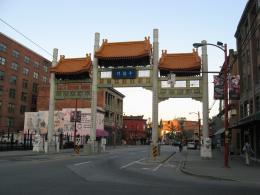Vancouver residents fight for culture in Chinatown

By Deanna Cheng,
New Canadian Media
Special to The Post
Vancouver residents are petitioning the redevelopment of the 105 Keefer site in Chinatown because the new vision doesn't include enough community and cultural spaces. An advocate for Vancouver’s Chinatown has started a petition against rezoning a central block in the district because she says it would cost the site its heritage designation and distinct character.
Nicole So, a graduate of the University of British Columbia (UBC), says the rezoning of the 105 Keefer site from a historic area to a development district doesn’t create space for cross-cultural, intergenerational experiences. The 23-year-old advocate says the revised 105 Keefer plan is what “everyone” doesn’t want.
The revised rezoning application is for a 13-storey building by the Beedie Development Group that includes 127 residential units and 25 seniors social housing units on the second floor. It also has commercial space on the ground floor. The petition asks for more senior housing, as well as more community and cultural spaces. So aims to have at least 1,000 signatures e-mailed to the City of Vancouver by Dec. 1. Chinatown already has a vision,” So explains, referring to a 2002 Chinatown revitalization report.
The 14-page city document stated most participants want a “real” community and not something created solely for the benefit of tourists and visitors. “There was frequent mention of the importance of inclusiveness of Chinatown – for Chinese of various linguistic and cultural backgrounds as well as non-Chinese speakers, for young and old,” states the report.
The report showed community members wanted a sense of festivity in Chinatown and to make it a “cool” place to visit, especially for youth. So mentions the Nikkei National Museum and Cultural Centre in Burnaby as an ideal example of culturally sensitive space. The centre focuses on preserving and promoting Japanese Canadian culture.
Houtan Rafii, vice-president of residential development at Beedie Living (the home-building division of Beedie Development Group), said in an e-mailed statement that the company would work with the city on expanding and enhancing the nearby Memorial Plaza, a space with a monument for Chinese Canadian soldiers who represented Canada in past wars.
The statement said many Chinatown stakeholders received the amendments Beedie Living made favourably.
The City of Vancouver said in an e-mail to New Canadian Media that an increase in the building’s height from 90 feet to a maximum of 120 feet to support public benefits including heritage, cultural, affordable and social housing projects is under consideration.
The city encourages concerned individuals to provide feedback by early January. Community members have repeatedly said to the media and city hall that they don’t want another Yaletown, a ‘yuppie’ section of Vancouver with dog salons and condos galore.
Toronto realtor Vivian Kim visited Vancouver in July for four days and wrote to someone in a Facebook group, “You must eat the garlic wings at Phnom Penh in Gastown!”
Phnom Penh, a well-known Cambodian-Vietnamese restaurant, is actually located in Chinatown. “In my memory, Gastown and Chinatown all melded into the same kind of look,” recalls 33-year-old Kim during a phone interview. “It didn’t jump out to me as a big Chinatown,” she adds.
Kim says in comparison Toronto has a handful of Chinatowns with distinct neighbourhoods. She describes the one downtown as having an abundance of Chinese signage in red and gold, outdoor food markets and local mom and pop businesses.
Susanna Ng, co-owner of New Town Bakery & Restaurant in Vancouver’s Chinatown, says people often complain about Chinese businesses closing down and moving out due to changing economy and residents. From her perspective though, business is good. She says her clientele tends to be more Caucasians and young people. “[I] don’t see many old people now. They’re in nursing homes or passed away.”
As Chinese business owners are getting older, they are retiring, Ng adds. “Their kids, the second generation, don’t want to take over the place. They sell it instead, so no more local businesses.”
Ng even struggles to find replacements for her restaurant staff, having had two cooks who retired recently. “In the Chinese newspapers, every time I open [them], the ads for ‘cooks wanted’ grow bigger and bigger. This is what I have to fight with.”
While the past fades away, a new Chinatown in Vancouver is being rebuilt and young Chinese students are eager to be part of the vision. International student Jane Jing Yi Wu is studying visual arts at UBC and she is working on a blueprint for the Keefer block.
The 22-year-old Chinese national pulls ideas from her home, the China she knows. Wu wants to incorporate space for community art, family-oriented nightlife and food markets. When Wu first came to Vancouver three years ago, she was neutral about Chinatown. After learning about Chinatown’s history in an Asian migration course, Wu started to care more.
Walking through the area, she thought of how the Chinese people paid the head tax, fought for their rights and survived in a new country years ago. She said that even though she’s an “outsider”, she wants the city to know that she cares. “I’m not Canadian, but I feel it’s time for us to do something for [future Chinese migrants].”
This piece was originally published in New Canadian Media.









